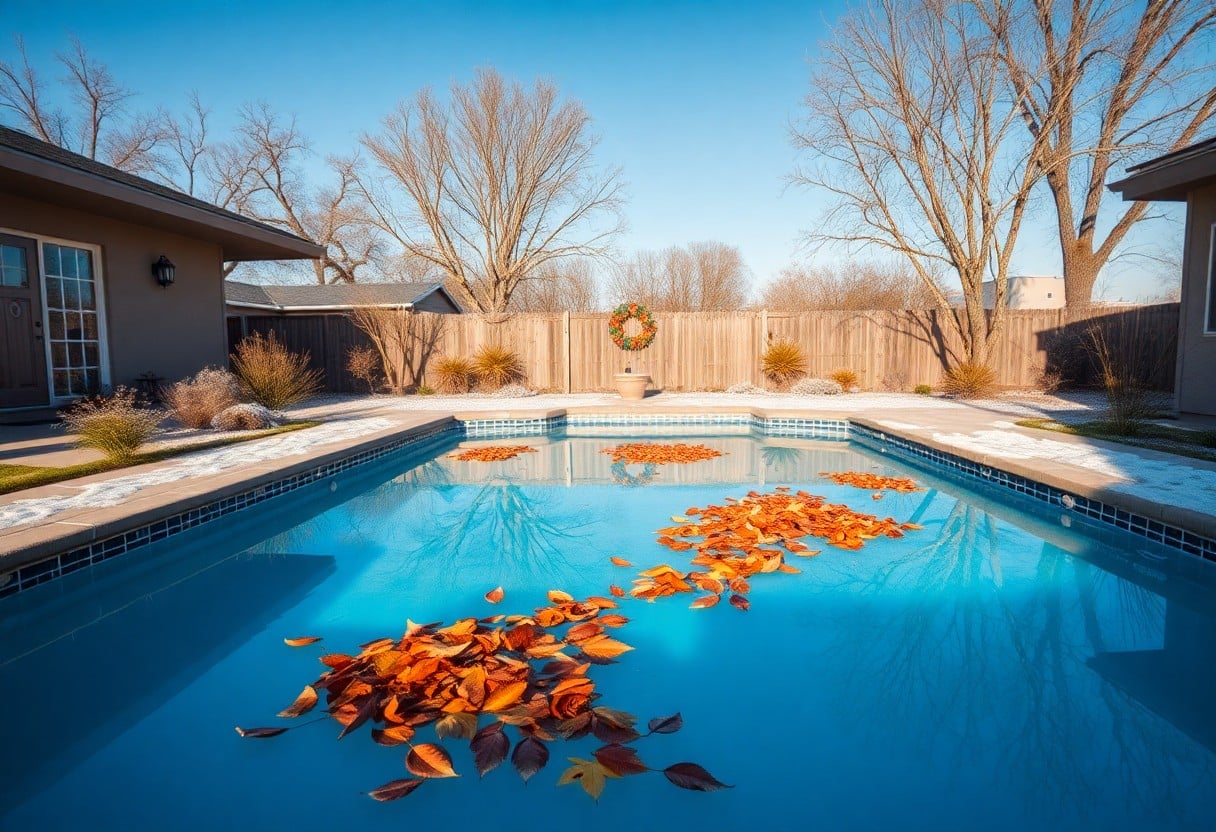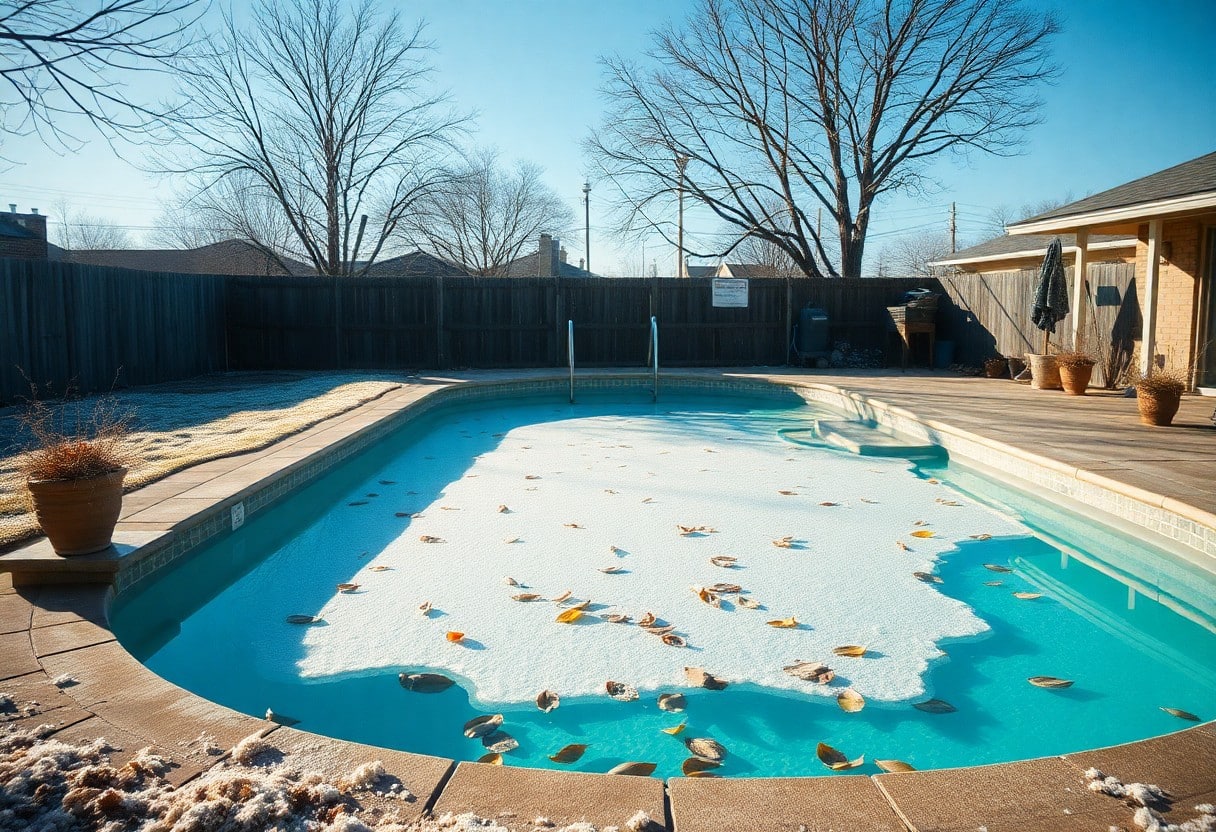Many pool owners in Texas face the challenge of winterizing their pools to protect them from harsh weather and temperature fluctuations. In this guide, you will learn the necessary steps to properly winterize your pool, ensuring it remains in good condition until the warmer months return. From balancing water chemistry to covering your pool securely, we’ll provide you with practical tips tailored to Texas weather. Follow these straightforward instructions to safeguard your investment and make reopening your pool a breeze next spring.
Preparing Your Pool: Essential Steps for Winter Readiness
Successfully winterizing your pool involves a systematic approach to ensure it remains protected throughout the cold months. Begin by thoroughly cleaning the pool, effectively removing debris, and preparing the water chemistry. Each step plays a vital role in safeguarding your investment and keeping maintenance manageable come spring.
Cleaning and Balancing Water Chemistry
Start by skimming the surface, vacuuming the bottom, and brushing the walls to eliminate dirt and debris. Once the pool is clean, check the water chemistry, ensuring pH levels are between 7.2 and 7.6 and alkalinity is within an appropriate range. Adjusting the calcium hardness can also prevent damage to pool surfaces during freezing temperatures.
Removing Accessories and Equipment
Remove all accessories, such as ladders, slides, and toys, before closing your pool for the winter. This not only protects your items from potential weather damage but also minimizes debris accumulation. Additionally, ensure that all filter systems and pumps are dismantled, drained, and stored properly to prevent freezing and breaking.
Taking the time to remove accessories such as ladders and pool covers can significantly extend their lifespan. Detach any removable pieces and store them in a dry, sheltered location. This prevents potential rust or corrosion as well as potential damage from ice accumulation. For your pool pump and filter, ensure they are thoroughly drained and stored indoors, eliminating any risk of freeze damage that can be costly to repair. Adopting this methodical approach during winter preparation not only promotes the longevity of your equipment but also ensures a hassle-free reopening when warmer weather arrives.

Securing Pool Equipment for the Cold Months
Protecting your pool equipment during winter in Texas requires thoughtful preparation. Ensuring that every component, from pumps to heaters, is properly secured can save you the hassle and expense of replacing damaged equipment come spring. Regularly check your equipment’s manufacturer guidelines for optimal procedures and techniques tailored to your specific models. This proactive approach allows you to extend the life of your pool assets while maintaining a safe and functional pool environment.
Properly Draining and Storing Components
Start by thoroughly draining your pool pump, filter, and heater to prevent any remaining water from freezing and causing cracks. Remove all water from the hoses and plug the inlets and outlets before storing them for the winter. Keep these components in a dry and sheltered area, ideally indoors or in a well-insulated shed, to protect them from extreme temperature fluctuations.
Strategies for Preventing Freeze Damage
To minimize the risk of freeze damage, consider using insulated covers and heat strips specifically designed for pool pumps and heaters. Likewise, maintaining a constant flow of water through your plumbing system by running your pump for a few hours each day even during the colder months can help avoid freezing. For added protection, a pool cover can not only keep debris out but also help retain warmth, creating a more stable environment for your equipment.
Building on these strategies, it’s advisable to monitor the weather conditions regularly and anticipate any sudden cold snaps by implementing backup measures, like wrapping vulnerable equipment with insulating blankets. Additionally, research the installation of a freeze guard, a helpful device that automatically turns on your pump when temperatures drop to a pre-set level, ensuring continuous water movement and protecting your plumbing from freezing. Taking these precautions will help ensure that your pool equipment remains undamaged during the winter months, making spring opening a stress-free experience.

Protecting Your Pool Structure from the Elements
Safeguarding your pool structure from harsh winter conditions is important for maintaining its integrity. In Texas, winter can bring unexpected freezes and temperature swings, so implementing effective protection measures ensures your investment lasts for years. By using the right pool cover and insulating sensitive areas, you can minimize the risks posed by cold weather and prevent costly repairs down the line.
Selecting the Right Pool Cover
Your pool cover plays a key role in protecting the pool’s surface from debris and reducing heat loss during the winter months. Opt for a durable, weather-resistant cover that fits snugly to prevent water accumulation and keep out debris. Solid or mesh covers are popular choices; solid covers block sunlight while mesh allows for drainage, reducing the risk of water pooling on top.
Insulating Areas Prone to Temperature Fluctuations
Identify areas around your pool that are susceptible to temperature variations. Insulating plumbing lines, skimmers, and equipment can prevent freezing and potential breakage. You might consider pipe insulation sleeves or heat tape for vulnerable pipes and investing in an insulated cover for skimmers to minimize cold air contact to enhance your pool’s winter preparedness.
| Protective Material | Purpose |
| Pipe Insulation Sleeves | Prevents freezing of water in pipes |
| Heat Tape | Maintains warm temperatures in critical areas |
| Insulated Skimmer Covers | Reduces cold air exposure |
Addressing temperature fluctuations can be particularly beneficial in maintaining your pool’s operational components, like pumps and filters. Apply insulation around vulnerable equipment with heavy-duty wraps or insulating jackets designed specifically for pool machinery. This not only helps ward off damage due to freezing temperatures but also promotes energy efficiency during the winter months. Assess these areas regularly to ensure they remain protected throughout the season.
| Insulation Type | Application |
| Wraps | Cover pumps and filters |
| Foam Boards | Insulate walls and floor areas |
| Heating Pads | Supply heat to specific equipment |

Monitoring Environmental Factors During Winter
Keeping an eye on environmental conditions can prevent unforeseen damage to your pool during the winter months. By consistently monitoring temperature fluctuations and precipitation, you ensure that your pool remains in optimal condition. Here are some key factors to observe:
- Daily temperature changes
- Rainfall amounts
- Wind speed and direction
- Ice formation on the water surface
Assume that by staying proactive about these factors, you can mitigate potential issues before they escalate.
Understanding Texas Winter Weather Patterns
Texas winter weather can be unpredictable, often swinging between warm sunny days and frigid cold snaps. Knowing the historical patterns for your region aids in making informed decisions about your pool winterization processes. Typical winter temperatures range from the mid-30s to mid-60s, occasionally dipping below freezing, particularly in northern areas. This variability can impact how you prepare your pool, particularly regarding freezing temperatures.
Maintaining Regular Checks on Your Pool
Scheduling regular checks on your pool throughout the winter season is necessary to catching potential issues early. You should inspect water levels, check for ice buildup, and monitor your cover’s integrity to ensure it’s functioning properly. Looking deep into these factors keeps possible winter-related problems at bay.
Setting a weekly reminder to perform these checks will help maintain your pool’s health. For example, you can periodically adjust water chemistry levels or ensure that your cover is secure. Pay attention to any unusual shifts or leaks, and should you find any problematic areas, address them promptly to reduce repair costs later. Taking these small steps can save you headaches come springtime.
The Long-Term Benefits of Effective Winterization
Winterizing your pool effectively brings long-lasting advantages that extend beyond the winter months. By ensuring that your pool is properly prepared for the cold, you can enhance its lifespan, maintain its efficiency, and ultimately enjoy a more seamless reopening come spring. This proactive approach can save you from unexpected complications while preserving the beauty and functionality of your pool for years to come.
Enhancing Longevity and Performance of Your Pool
Proper winterization techniques play a vital role in extending the life of your pool’s equipment and surfaces. By treating water chemistry and protecting surfaces from freezing temperatures, you prevent cracks, leaks, and deterioration. Investing a little time during winter can translate into a pool that operates efficiently and looks pristine for many summers ahead.
Cost Savings: Preventing Repairs Through Winterization
Effective winterization can lead to significant savings by preventing costly repairs that arise from neglect. Thoroughly preparing your pool reduces wear and tear, minimizes the risk of equipment failure, and avoids structural damage caused by freeze-thaw cycles. By addressing these potential issues ahead of time, you protect your investment and keep your wallet happy.
Investing in winterization reduces the likelihood of serious repairs that can cost hundreds or even thousands of dollars. For example, replacing a cracked fiberglass shell or faulty equipment can strain your budget. In contrast, a thorough winterization process, including draining water from pipes, adding antifreeze, and securing covers, can mitigate these risks. Plus, regular maintenance routines established during winterization lead to more efficient operation, ensuring that you save on your utility bills year-round. Making winter preparation a priority not only saves you money but enhances your peace of mind knowing your pool is safeguarded against the elements.
To wrap up
Conclusively, winterizing your pool in Texas involves a series of straightforward yet crucial steps to protect your investment during colder months. You should start by thoroughly cleaning your pool, balancing the water chemistry, and adding winterizing chemicals. Draining excess water from the plumbing lines and covering your pool are also key. By taking these actions, you ensure your pool remains in good condition and is ready for use once warmer weather returns. Following this guide will help you maintain your pool’s integrity and enjoyment for years to come.
